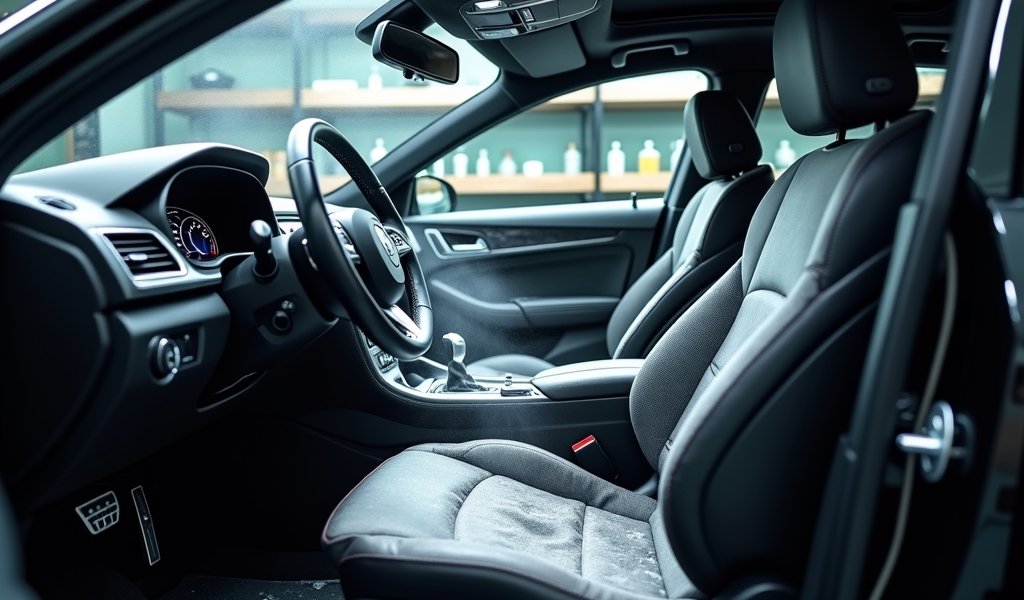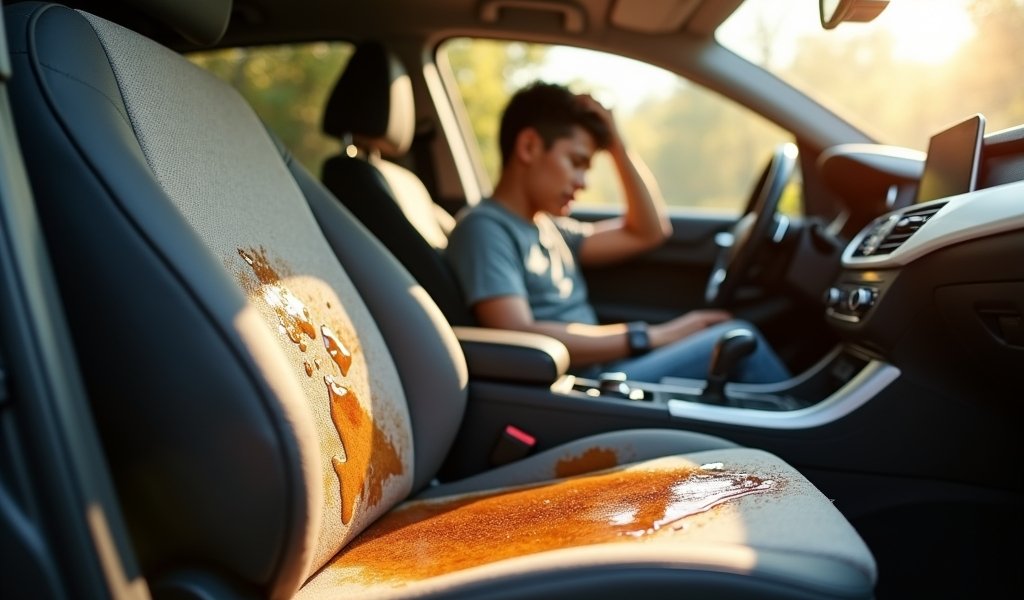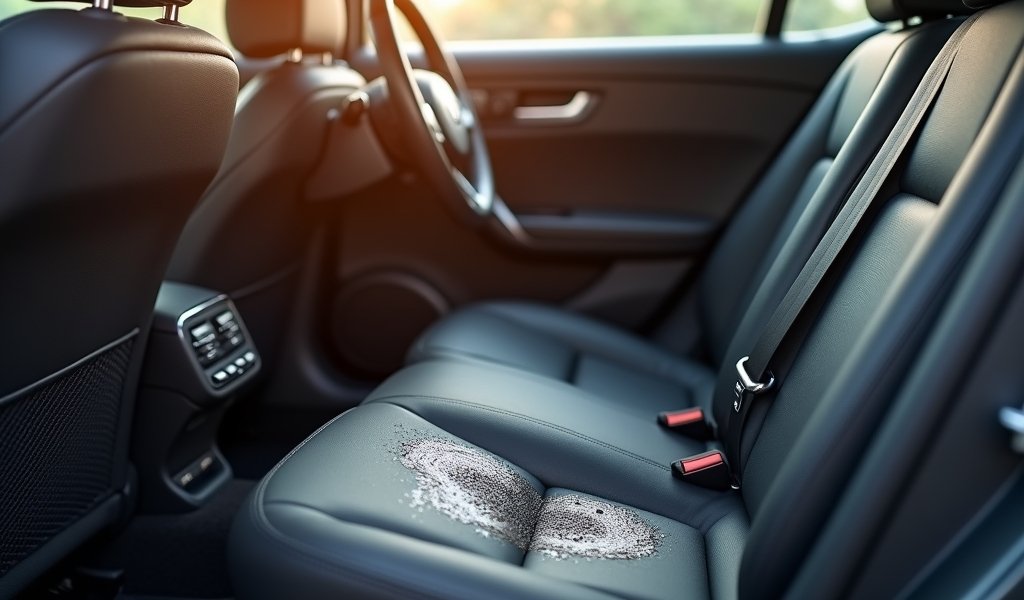Overview
This article presents five effective methods for removing car upholstery stains: vinegar and dish soap solution, baking soda, commercial cleaners, steam cleaning, and club soda for quick response, along with preventative maintenance tips. Each cleaning approach targets different types of stains and upholstery materials, helping readers maintain their vehicle’s interior appearance, preserve its value, and create a healthier environment for passengers.
Table of Contents
- Understanding Car Seat Stains: More Than Just an Eyesore
- The Vinegar and Dish Soap Solution: Nature’s Dynamic Duo
- Baking Soda Magic: Your Stain-Fighting Superhero
- Commercial Upholstery Cleaners: When You Need Professional Power
- Steam Cleaning: The Deep Heat Treatment for Stubborn Stains
- Club Soda to the Rescue: Your Quick Response Solution
- Prevention Tips: Stop Stains Before They Happen
- Conclusion: Driving Clean and Confident
- Frequently Asked Questions
Understanding Car Seat Stains: More Than Just an Eyesore
Have you ever slammed on the brakes only to watch your morning coffee perform an acrobatic routine across your car seats? That sinking feeling in your stomach isn’t just about the lost caffeine—it’s about the stubborn stain that’s about to become part of your daily commute.
Car seat stains aren’t merely cosmetic concerns. They’re silent value-killers that can reduce your vehicle’s resale worth by hundreds or even thousands of dollars. According to a Consumer Reports study, a well-maintained interior can increase a vehicle’s resale value by up to 10%.
Beyond the financial impact, stained upholstery harbors bacteria, allergens, and unpleasant odors that can affect your health and driving experience. That mysterious spot from last summer’s road trip might be housing more than just memories.
As a professional mechanic who’s seen thousands of vehicle interiors in various states of distress, I can tell you that most car seat stains fall into a few common categories:
- Liquid spills (coffee, soda, juice)
- Food stains
- Grease and oil transfers
- Mud and dirt buildup
- Mystery stains (often a combination of the above)
The good news? With the right approach and a little elbow grease, almost any stain can be conquered. Let’s dive into five battle-tested methods that will transform your car’s interior from “lived in” to “luxury.”
The Vinegar and Dish Soap Solution: Nature’s Dynamic Duo
Sometimes the most powerful cleaning solutions aren’t hiding behind fancy labels and hefty price tags—they’re sitting right in your kitchen cabinet. White vinegar and dish soap create a cleaning powerhouse that cuts through everything from coffee drips to mysterious kid-created concoctions.
Why does this humble combination work so effectively? Vinegar’s acetic acid breaks down stain molecules while dish soap lifts away oils and grease. Together, they’re like the Batman and Robin of car upholstery cleaning.
Here’s what you’ll need for this DIY car seat stain remover:
- 1 cup white vinegar
- 1 tablespoon gentle dish soap
- 2 cups warm water
- Spray bottle
- Clean microfiber cloths
- Soft-bristled brush
Follow this step-by-step process for best results:
- Combine vinegar, dish soap, and warm water in your spray bottle and shake gently to mix.
- Test the solution on a small, hidden area of your upholstery to ensure colorfastness.
- Spray the stained area lightly—your goal is damp, not soaked.
- Using your soft-bristled brush, work in gentle circular motions from the outside of the stain inward.
- Wipe away residue with a clean, damp microfiber cloth.
- Allow the area to air dry completely or use a fan to speed the process.
This method works wonders on water-based stains like coffee, soda, and most food spots. However, proceed with caution on leather seats—vinegar can be too harsh for these premium surfaces. For leather upholstery, I’d recommend proper leather-specific cleaners that won’t compromise the material’s integrity.
One of my customers, Sarah from Portland, swears this solution saved her cream-colored cloth seats after her toddler’s juice box explosion. “I was convinced I’d need to replace the entire back seat,” she told me. “But after two treatments with the vinegar solution, you can’t even tell where the spill happened.”

Baking Soda Magic: Your Stain-Fighting Superhero
When faced with stubborn stains that have seemingly fused with your upholstery at a molecular level, baking soda steps up as your gentle abrasive hero. This household staple does double duty by both lifting embedded grime and neutralizing those not-so-fresh odors that often accompany deep stains.
Think of baking soda as the patient problem-solver in your cleaning arsenal. Unlike harsh chemicals that attack stains aggressively, baking soda works gradually through absorption and mild abrasion to lift stains without damaging fibers.
For cloth upholstery, follow this proven technique:
- Vacuum seats thoroughly to remove surface debris and dust.
- Lightly dampen (not soak) the stained area with clean water.
- Generously sprinkle baking soda over the entire stain.
- Using a spray bottle, mist the baking soda lightly with water until it forms a paste.
- Let it sit for at least 30 minutes—this crucial dwell time allows the baking soda to work its magic.
- Using a soft brush, gently work the paste into the stain using circular motions.
- Vacuum thoroughly to remove all baking soda residue.
For leather and vinyl surfaces, you’ll need a gentler approach:
- Create a paste using three parts baking soda to one part water.
- Apply with a soft cloth using gentle circular motions.
- Wipe clean after just 15 minutes to prevent any potential drying or cracking.
- Follow with an appropriate leather conditioner.
Baking soda excels at treating:
- Oil-based stains
- Food grease
- Body oil buildup on headrests
- Pet accident odors
After treating stains with baking soda, consider applying a fabric protector to prevent future spills from setting so deeply. Think of it as giving your seats a protective shield against life’s inevitable messes—an ounce of prevention worth a pound of cure.
Commercial Upholstery Cleaners: When You Need Professional Power
While homemade solutions have their place in your cleaning arsenal, sometimes you need the specialized formulations that commercial products offer—especially for set-in or particularly challenging stains that have withstood your DIY attempts.
Having spent years assessing which products actually deliver results rather than just promises, I can recommend several standouts in the commercial car seat stain remover category:
- Chemical Guys Lightning Fast Carpet & Upholstery Stain Extractor: Exceptional for deep stains with enzyme action
- Meguiar’s Carpet & Upholstery Cleaner: Great all-around performer with built-in scrubbing head
- Turtle Wax Power Out! Upholstery Cleaner: Budget-friendly with impressive stain-lifting power
- Bissell Professional Spot & Stain + Oxy: Borrows technology from home carpet cleaning for tough stains
The right product choice depends largely on your seat material. Fabric upholstery can generally handle stronger formulations, while leather and vinyl require pH-balanced, non-alcohol products to prevent damage. Many vehicle manufacturers specify recommended cleaning products—using non-approved cleaners could potentially affect your warranty coverage.
For maximum effectiveness with commercial cleaners, follow these professional tips:
- Work in a shaded, well-ventilated area to prevent premature drying.
- Apply product according to directions—more isn’t always better and can leave residue.
- Use the appropriate applicator (foam, microfiber, or brush) as recommended.
- Allow the specified dwell time for the cleaner to break down stains—rushing this step reduces effectiveness.
- Thoroughly remove all residue to prevent attracting more dirt.
Commercial cleaners typically range from $8-$25, making them an affordable alternative to professional detailing services that can run upwards of $150 for interior cleaning alone. They’re particularly valuable for those stubborn coffee spills that seem to have permanent residence in your upholstery.
Remember that most commercial cleaners contain chemicals that, while effective, should be used with proper ventilation. Always test new products on an inconspicuous area first—that hidden section under the seat is perfect for this purpose.
Steam Cleaning: The Deep Heat Treatment for Stubborn Stains
Think of steam cleaning as sending your car seat stains to the ultimate spa retreat—except instead of relaxation, they’re getting their eviction notice. The high-temperature steam penetrates deep into upholstery fibers, dissolving and lifting stubborn compounds while simultaneously sanitizing the surface.
Steam cleaning harnesses the power of physics in your favor. When water transforms into vapor at 212°F (100°C), it expands dramatically, forcing its way into tiny crevices and fabric weaves where liquid cleaners can’t reach. This expansion literally pushes dirt and stains to the surface where they can be wiped away.
You have several approaches to steam cleaning:
- Rent a professional-grade upholstery steamer ($25-40/day from most hardware stores)
- Invest in a handheld upholstery steamer ($60-150 for a quality unit)
- Hire professionals ($100-200 for complete interior treatment)
For the DIY approach with a rented or purchased steamer:
- Vacuum thoroughly to remove surface debris and prevent mud-like residue.
- Follow your steam cleaner’s instructions for water and any cleaning solution additions.
- Move the steamer slowly over the stained area, allowing hot vapor to penetrate completely.
- For particularly stubborn stains, hold the steamer head about an inch above the stain for 15-20 seconds.
- Use the brush attachment to gently agitate the loosened dirt.
- Extract moisture with the vacuum function if your unit has one.
The drying process after steam cleaning is crucial. Damp upholstery can develop mildew and musty odors if not dried properly. Open all doors and windows, use fans if possible, and consider scheduling your cleaning for a warm, low-humidity day for faster evaporation.
Steam cleaning is particularly effective for:
- Deep-set food and beverage stains
- Mystery stains of unknown origin
- Sanitizing surfaces after illness
- Removing embedded pet hair and dander
One important caution: steam cleaning isn’t appropriate for all upholstery types. Professional detailers warn that excessive heat can damage certain synthetic materials and potentially shrink some fabric blends. Always check your vehicle’s upholstery care recommendations before proceeding.

Club Soda to the Rescue: Your Quick Response Solution
When disaster strikes in the form of a fresh spill, your response time matters more than your cleaning arsenal. Club soda might sound like an old wives’ tale, but its slightly acidic nature and carbonation make it surprisingly effective for fresh stains when every second counts.
The carbonation in club soda does the heavy lifting here. Those tiny bubbles work to physically push stain particles up and away from fabric fibers, while the slight acidity helps break down organic compounds found in many common car spills. It’s nature’s quick-response cleaning team.
For immediate stain treatment:
- Blot (never rub!) excess liquid with paper towels or a clean cloth.
- Pour club soda directly onto the fresh stain.
- Let it fizz for about 30 seconds—the carbonation is actively lifting the stain.
- Blot again with a clean cloth, working from the outside inward to prevent spreading.
- Repeat until no more color transfers to your cloth.
This method works particularly well on:
- Coffee and tea spills
- Wine and juice stains
- Soda spills (fighting fizz with fizz!)
- Light food stains
Consider keeping a small bottle of club soda in your vehicle for emergency cleaning. Unlike many cleaning products, it won’t degrade in hot cars, and it’s perfectly safe to store long-term. One customer told me he keeps a small bottle in his center console at all times after saving his light gray seats from a coffee disaster during morning traffic.
For optimal results, follow up with a more thorough cleaning using one of the previously discussed methods once you’ve removed the bulk of the stain. Think of club soda as your first aid before the complete treatment—it buys you time and prevents the stain from setting permanently.
Prevention Tips: Stop Stains Before They Happen
As with most of life’s challenges, prevention trumps cure when it comes to car upholstery. Developing a maintenance routine keeps your interior looking showroom-fresh with minimal effort, saving you both time and frustration down the road.
From my years in auto maintenance, I’ve learned that preventive measures pay huge dividends. Here are my top recommendations:
- Apply fabric protector sprays like Scotchgard every six months—creating an invisible barrier that repels liquids before they can penetrate.
- Invest in quality seat covers for vehicles that see heavy use, frequent little passengers, or regular pet transport.
- Keep a “quick response kit” in your glove compartment: microfiber cloths, travel-sized upholstery cleaner, and stain removal wipes.
- Establish reasonable food and drink policies for your vehicle—perhaps limiting certain messy foods or using travel containers.
- Schedule quarterly deep cleaning sessions to prevent dirt buildup—think of it as routine maintenance for your upholstery.
A consistent fifteen-minute weekly vacuum prevents dirt from embedding deeply into fabrics. This simple habit can save you hours of intensive cleaning later and extend your upholstery’s life substantially. It’s the automotive equivalent of brushing your teeth to prevent cavities rather than dealing with root canals later.
For those with children or pets—the ultimate stain-creating forces of nature—consider these specialized precautions:
- Waterproof seat protectors designed specifically for child safety seats
- Hammock-style pet covers that protect both the seats and the back of the front seats
- Removable, washable seat covers for easy maintenance
Remember that prevention doesn’t have to mean sacrifice. Modern fabric protectors are virtually undetectable once applied, and today’s seat covers range from utilitarian to luxury, with options to match any interior aesthetic.
Conclusion: Driving Clean and Confident
Your vehicle’s interior deserves the same attention as its exterior—perhaps even more, considering you spend far more time inside your car than admiring it from the outside. These five proven cleaning methods provide a comprehensive arsenal against everything from coffee catastrophes to mysterious marks from last summer’s road trip.
Each cleaning approach we’ve explored has its place in your maintenance toolkit:
- The vinegar and dish soap solution offers economical, everyday cleaning power
- Baking soda provides gentle yet effective stain lifting and odor neutralizing
- Commercial cleaners deliver specialized formulations for stubborn situations
- Steam cleaning provides deep sanitizing and stain extraction
- Club soda gives you quick-response capability for fresh spills
Remember that different stains and upholstery materials respond better to certain methods. Don’t be discouraged if your first attempt doesn’t completely eradicate a tough stain—sometimes a sequential approach using multiple methods yields the best results.
Maintaining clean car upholstery isn’t just about aesthetics. It’s about preserving your vehicle’s value, creating a healthier environment for passengers, and taking pride in your daily drive. After all, your car is more than transportation—it’s a personal space where you likely spend hours each week.
With these professional techniques in your cleaning arsenal, you can tackle virtually any upholstery challenge that comes your way. Drive confidently knowing that spills and stains are no longer permanent sentences but merely temporary inconveniences on your journey.
Frequently Asked Questions
What’s the best car seat stain remover for coffee spills?
For fresh coffee spills, club soda works remarkably well when applied immediately. For set-in coffee stains, a commercial cleaner containing enzymes or oxygen boosters will typically yield the best results.
Can I use bleach to clean my car upholstery?
Never use chlorine bleach on car upholstery as it can damage fibers, discolor fabrics, and weaken the material. Oxygen-based bleach alternatives are safer for stubborn stains when diluted properly.
How do I remove chewing gum from car seats?
Harden the gum with ice cubes in a plastic bag, then carefully scrape off with a plastic card. Any remaining residue can be treated with a small amount of peanut butter (the oils help dissolve the gum base) before cleaning with soap and water.
What’s safe to use on leather car seats?
Leather seats require pH-balanced cleaners specifically formulated for leather. Avoid vinegar, alcohol-based products, or all-purpose cleaners that can dry out and damage leather surfaces.
How often should I clean my car seats?
Light cleaning with vacuuming should be done weekly, while deeper cleaning is recommended quarterly for regular use vehicles. Immediate spot treatment should be performed whenever spills occur to prevent stains from setting.


Pingback: Remove Soda Stains From Car Seat: 5 Tips - knowsyourcar.com